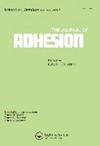硅烷化粘土对环氧涂层钢在天然海水中的阻隔性、疏水性和力学性能影响的研究
IF 2.3
4区 材料科学
Q2 ENGINEERING, CHEMICAL
引用次数: 6
摘要
摘要二乙氧基(3-缩水甘油基氧基丙基)甲基硅烷(GPMS)是一种表面改性剂,用于赋予海洛石纳米粒子疏水性,提高其在环氧聚合物(EP)中的分散能力。EP-GPMS/粘土涂层的表面粗糙度和疏水性(WCA:144°)都很高。采用电化学方法研究了涂层钢表面的腐蚀行为。EP-GPMS/粘土纳米复合涂层显示出比EP涂层高约63倍的涂层电阻。EP-GPMS/粘土显示出更好的涂层电阻(6687.71 kΩ.cm2),腐蚀电流密度(4.25μa/cm2)低于普通环氧树脂(1.01kΩ.cm2;287.21μA/cm2)。与纯EP(0.0599 mm/年)相比,EP-GPMS/粘土涂层样品的腐蚀速率最低(0.0017 mm/年。根据SECM数据,在浸渍15 d时,EP-GPMS/粘土涂层表面的Fe耗散(2.6 nA)远小于普通EP(14.7 nA)。此外,EP-GPMS/粘土显示出增强的粘合性能。含有硅烷化粘土的EP具有出色的拒氧、防水、疏水和阻隔性能。由于粘土/硅烷的环境安全性,这种涂层可能被用作工业应用的可行涂层物质。本文章由计算机程序翻译,如有差异,请以英文原文为准。
A study on the influence of silanized clay on the barrier, hydrophobic and mechanical properties of epoxy coated steel in natural seawater
ABSTRACT Diethoxy(3-glycidyloxypropyl) methylsilane (GPMS), a surface modification agent, is used to give halloysite nanoparticles a hydrophobic behaviour and improve their ability to disperse in epoxy polymers (EP). Surface roughness and hydrophobicity (WCA: 144°) are both quite high in EP-GPMS/Clay coatings. The corrosion behavior of coated steel surfaces was investigated using electrochemical methods. The EP-GPMS/clay nanocomposite coating was shown to have about 63 times higher coating resistance than the EP coating. The EP-GPMS/Clay displayed better coating resistance (6687.71 kΩ.cm2) and a lower corrosion current density (4.25 μA/cm2) than plain epoxy (1.01 kΩ.cm2; 287.21 μA/cm2) even after prolonged exposure to the electrolyte, according to electrochemical studies. Compared to the pure EP (0.0599 mm/year), the EP-GPMS/clay coated sample had the lowest corrosion rate (0.0017 mm/year). According to SECM data, at 15 d of immersion, the Fe dissipation at the surface of the EP-GPMS/Clay coating (2.6 nA) is much smaller than the plain EP (14.7 nA). Additionally, the EP-GPMS/Clay showed enhanced adhesive properties. The EP with silanized clay offers an outstanding oxygen and water repellent, hydrophobic, and barrier properties. Due to the environmental safety of clay/silane, this kind of coating might be employed as a workable coating substance for industrial applications.
求助全文
通过发布文献求助,成功后即可免费获取论文全文。
去求助
来源期刊

Journal of Adhesion
工程技术-材料科学:综合
CiteScore
5.30
自引率
9.10%
发文量
55
审稿时长
1 months
期刊介绍:
The Journal of Adhesion is dedicated to perpetuating understanding of the phenomenon of adhesion and its practical applications. The art of adhesion is maturing into a science that requires a broad, coordinated interdisciplinary effort to help illuminate its complex nature and numerous manifestations.
 求助内容:
求助内容: 应助结果提醒方式:
应助结果提醒方式:


